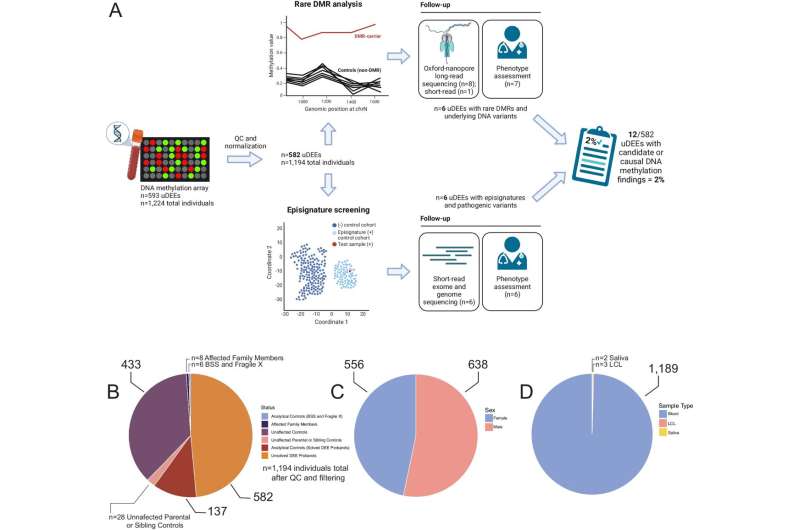This article has been reviewed according to Science X's editorial process and policies. Editors have highlighted the following attributes while ensuring the content's credibility:
fact-checked
peer-reviewed publication
trusted source
proofread
Scientists use DNA methylation patterns as roadmap for identifying causes of severe epilepsies in children

To effectively treat a disease or disorder, doctors must first know the root cause. Such is the case for developmental and epileptic encephalopathies (DEEs), whose root causes can be hugely complex and heterogeneous.
Scientists at St. Jude Children's Research Hospital demonstrated the value of DNA methylation patterns for identifying the root cause of DEEs, showing specific gene methylation and genome-wide methylation "episignatures" can help identify the genes that cause DEE. The findings were published today in Nature Communications.
DEEs affect 1 in 590 children and involve more than 825 genes. Current testing methods can clinically identify the root cause, or etiology, of approximately 50% of individuals' DEEs, which guides clinicians and families to appropriate care and support. However, the remaining half of all patients' etiologies remain unsolved.
"About half of the patients with DEE will get a diagnosis, and half of them won't," said co-corresponding author Heather Mefford, MD, Ph.D., St. Jude Center for Pediatric Neurological Disease Research and Department of Cell & Molecular Biology.
When a child is diagnosed with DEE, linking the encephalopathy to a specific gene can allow the clinician to provide appropriate treatment or control over the symptoms of the disorder. This knowledge is also invaluable to the family.
"The half who do not receive a diagnosis not only won't be able to get gene-specific recommendations in their therapy, they won't be able to link with family organizations that can connect them with other families with children that also have mutations in that gene," explained Mefford.
The value of identifying rare genetic links to DEE
Addressing the genetic root causes for DEEs has been a long-term goal for Mefford, who was instrumental in raising the number of diagnosable cases to 50%, up from approximately 5% just a decade ago.
Today, 80% of identifiable DEEs can be explained by 27 genes. To tackle the remaining unsolved cases, the numerous rare occurrences of the disorder must be identified, a challenge that co-first author and St. Jude Graduate School of Biomedical Sciences student Christy LaFlamme embraced.
"One way we can get at the remaining 50% is by exploring what traditional tests don't look at," said LaFlamme. "Current tests don't look at noncoding space that regulates gene expression. A lot of these disorders are due to losing expression of epilepsy genes."
DNA methylation fingerprint offers solution
Mefford is exploring epigenetics, the changes in gene expression that may or may not involve DNA alterations, as a potential solution. One such epigenetic change involves a process vital to gene expression called DNA methylation. This process is akin to a chef leaving notes beside a recipe instructing the reader to skip or repeat a step.
"For some genetic disorders, everyone with a mutation in the same gene has a methylation profile across their genome that puts them in a category with all the others with the same genetic disorder," said Mefford. This methylation landscape is called an "episignature" and is akin to a DEE fingerprint.
While episignatures allowed the researchers to broadly identify DEE-causing variants, taking a closer look at the individual methylation instances, referred to as rare methylation analysis, presented another opportunity.
"The underlying cause of the disease ends up manifesting into an episignature that can serve as a marker for that gene," explained LaFlamme. "With rare methylation events, their analysis can point directly to the cause of the disease."
New technologies aid in rare methylation detection
Exploring these rare methylation events across the genome using long-read DNA sequencing pointed the researchers toward DNA regions that are not commonly assessed, offering an answer to the cause of these cases.
This one-two punch allowed the researchers to identify the causative and candidate etiologies of DEEs in 2% of previously unidentified cases. This represents another significant step in identifying rare instances of DEEs and another tool to aid in diagnosing children with DEE.
Mefford is determined to continue chipping away in earnest. Her placement within the St. Jude Pediatric Translational Neuroscience Initiative means the so-called "N of few," the rarer occurrences of neurological disorders like DEE, can continue to be tackled.
"We are still dedicated to trying to solve the remaining cases. We've always leveraged new technologies, such as next-generation sequencing 10 years ago and now methylation analysis and long-read sequencing," said Mefford. "We're always looking for technologies that will give us new information to try and solve those cases."
More information: Christy W. LaFlamme et al, Diagnostic utility of DNA methylation analysis in genetically unsolved pediatric epilepsies and CHD2 episignature refinement, Nature Communications (2024). DOI: 10.1038/s41467-024-50159-6


















